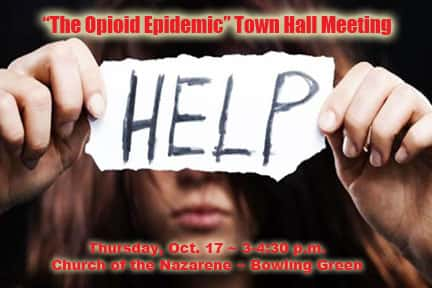
PIKE COUNTY – Pike County residents are encouraged to attend a town hall meeting that is focused on gathering information on the impact of substance abuse and addiction in the community on Thursday, Oct. 17 at the Bowling Green Church of the Nazarene.
The meeting will be held from 3-4:30 p.m. at the chuch. Local healthcare officials are hoping to gain input and perspective on what the area needs to better address and combat the problems associated with the opioid epidemic.
Rhonda Stumbaugh, of the Pike County Health Department, acknowledged the area is no different than other communities across the nation dealing with the deadly effects of drug addiction.
She pointed out a grant has been secured to research the opioid epidemic locally. It is hoped that after talking to members of the community, gaps in care can be identified and a plan can be drawn up to address those needs.
A three-year grant will be sought to put the plan into place locally. The grant is being administered by the Pike County Rural Community Opioid Response Planning Consortium which includes Pike County Memorial Hospital, the Pike County Health Department, Pike County Sheriff’s Department, Northeast Correctional Center, and The Aviary Recovery Center. Additional members are in the process of joining the team.
For more information on the meeting, contact Lisa Pitzer at PCMH, 573-754-5531 or Stumbaugh at the Health Department, 573-324-2111.
The project is supported by the Health Resources and Services Administration (HRSA) of the United States Department of Health and Human Services (HHS). 
Opioids refer to a wide range of drugs, including legal narcotics to illegal drugs such as heroin. Whether an opioid is an illegal street drug or one prescribed by a doctor, the National Institute on Drug Abuse (NIDA) notes that all are chemically related. Each opioid interacts with opioid receptors on nerve cells in the body and brain. Prescription opioids are often prescribed to relieve pain.
According to the NIDA, opioids are effective at reducing pain. But while they are prescribed to treat pain, opioids also produce a feeling of euphoria.
Opioid users, whether they're using heroin or a prescription opioid such as Vicodin, can easily become dependent on opioids because of that euphoric feeling they get when taking them. When this happens, users are likely to misuse opioids, taking them in larger quantities than prescribed or looking to illegal opioids, such as heroin, in search of that euphoric feeling.
TYPES OF OPIOIDS
· Prescription opioids: These are prescribed by doctors to treat moderate to severe pain. Some common types of prescription opioids are Vicodin (hydrocodone), OxyContin (oxycodone), morphine, and methadone.
· Fentanyl: This is a synthetic opioid that the CDC notes is considerably more powerful than other opioids. Fentanyl is typically only prescribed to help patients dealing with severe pain, such as that caused by advanced cancers. However, illegally manufactured and distributed fentanyl is at the heart of the opioid epidemic. In fact, the CDC reports that death rates from overdoses involving synthetic opioids such as fentanyl doubled in 10 states from 2015 to 2016.
· Heroin: Unlike fentanyl and prescription opioids, heroin is illegal. Despite that, heroin usage has risen sharply in recent years across nearly all demographics in the United States.